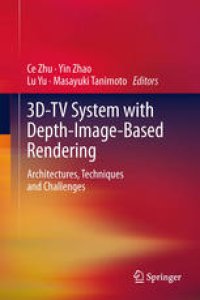
Ebook: 3D-TV System with Depth-Image-Based Rendering: Architectures, Techniques and Challenges
Author: Yin Zhao Ce Zhu Lu Yu Masayuki Tanimoto (auth.) Ce Zhu Yin Zhao Lu Yu Masayuki Tanimoto (eds.)
- Tags: Signal Image and Speech Processing, Image Processing and Computer Vision, Multimedia Information Systems
- Year: 2013
- Publisher: Springer-Verlag New York
- Edition: 1
- Language: English
- pdf
Riding on the success of 3D cinema blockbusters and advances in stereoscopic display technology, 3D video applications have gathered momentum in recent years. 3D-TV System with Depth-Image-Based Rendering: Architectures, Techniques and Challenges surveys depth-image-based 3D-TV systems, which are expected to be put into applications in the near future. Depth-image-based rendering (DIBR) significantly enhances the 3D visual experience compared to stereoscopic systems currently in use. DIBR techniques make it possible to generate additional viewpoints using 3D warping techniques to adjust the perceived depth of stereoscopic videos and provide for auto-stereoscopic displays that do not require glasses for viewing the 3D image.
The material includes a technical review and literature survey of components and complete systems, solutions for technical issues, and implementation of prototypes. The book is organized into four sections: System Overview, Content Generation, Data Compression and Transmission, and 3D Visualization and Quality Assessment. This book will benefit researchers, developers, engineers, and innovators, as well as advanced undergraduate and graduate students working in relevant areas.
Riding on the success of 3D cinema blockbusters and advances in stereoscopic display technology, 3D video applications have gathered momentum in recent years. 3D-TV System with Depth-Image-Based Rendering: Architectures, Techniques and Challenges surveys depth-image-based 3D-TV systems, which are expected to be put into applications in the near future. Depth-image-based rendering (DIBR) significantly enhances the 3D visual experience compared to stereoscopic systems currently in use. DIBR techniques make it possible to generate additional viewpoints using 3D warping techniques to adjust the perceived depth of stereoscopic videos and provide for auto-stereoscopic displays that do not require glasses for viewing the 3D image.
The material includes a technical review and literature survey of components and complete systems, solutions for technical issues, and implementation of prototypes. The book is organized into four sections: System Overview, Content Generation, Data Compression and Transmission, and 3D Visualization and Quality Assessment. This book will benefit researchers, developers, engineers, and innovators, as well as advanced undergraduate and graduate students working in relevant areas.
Riding on the success of 3D cinema blockbusters and advances in stereoscopic display technology, 3D video applications have gathered momentum in recent years. 3D-TV System with Depth-Image-Based Rendering: Architectures, Techniques and Challenges surveys depth-image-based 3D-TV systems, which are expected to be put into applications in the near future. Depth-image-based rendering (DIBR) significantly enhances the 3D visual experience compared to stereoscopic systems currently in use. DIBR techniques make it possible to generate additional viewpoints using 3D warping techniques to adjust the perceived depth of stereoscopic videos and provide for auto-stereoscopic displays that do not require glasses for viewing the 3D image.
The material includes a technical review and literature survey of components and complete systems, solutions for technical issues, and implementation of prototypes. The book is organized into four sections: System Overview, Content Generation, Data Compression and Transmission, and 3D Visualization and Quality Assessment. This book will benefit researchers, developers, engineers, and innovators, as well as advanced undergraduate and graduate students working in relevant areas.
Content:
Front Matter....Pages i-xii
Front Matter....Pages 1-1
An Overview of 3D-TV System Using Depth-Image-Based Rendering....Pages 3-35
Front Matter....Pages 37-37
Generic Content Creation for 3D Displays....Pages 39-68
Stereo Matching and Viewpoint Synthesis FPGA Implementation....Pages 69-106
DIBR-Based Conversion from Monoscopic to Stereoscopic and Multi-View Video....Pages 107-143
Virtual View Synthesis and Artifact Reduction Techniques....Pages 145-167
Hole Filling for View Synthesis....Pages 169-189
LDV Generation from Multi-View Hybrid Image and Depth Video....Pages 191-220
Front Matter....Pages 221-221
3D Video Compression....Pages 223-248
Depth Map Compression for Depth-Image-Based Rendering....Pages 249-276
Effects of Wavelet-Based Depth Video Compression....Pages 277-298
Transmission of 3D Video over Broadcasting....Pages 299-344
Front Matter....Pages 345-345
The Psychophysics of Binocular Vision....Pages 347-373
Stereoscopic and Autostereoscopic Displays....Pages 375-411
Subjective and Objective Visual Quality Assessment in the Context of Stereoscopic 3D-TV....Pages 413-437
Visual Quality Assessment of Synthesized Views in the Context of 3D-TV ....Pages 439-473
Back Matter....Pages 475-478
Riding on the success of 3D cinema blockbusters and advances in stereoscopic display technology, 3D video applications have gathered momentum in recent years. 3D-TV System with Depth-Image-Based Rendering: Architectures, Techniques and Challenges surveys depth-image-based 3D-TV systems, which are expected to be put into applications in the near future. Depth-image-based rendering (DIBR) significantly enhances the 3D visual experience compared to stereoscopic systems currently in use. DIBR techniques make it possible to generate additional viewpoints using 3D warping techniques to adjust the perceived depth of stereoscopic videos and provide for auto-stereoscopic displays that do not require glasses for viewing the 3D image.
The material includes a technical review and literature survey of components and complete systems, solutions for technical issues, and implementation of prototypes. The book is organized into four sections: System Overview, Content Generation, Data Compression and Transmission, and 3D Visualization and Quality Assessment. This book will benefit researchers, developers, engineers, and innovators, as well as advanced undergraduate and graduate students working in relevant areas.
Content:
Front Matter....Pages i-xii
Front Matter....Pages 1-1
An Overview of 3D-TV System Using Depth-Image-Based Rendering....Pages 3-35
Front Matter....Pages 37-37
Generic Content Creation for 3D Displays....Pages 39-68
Stereo Matching and Viewpoint Synthesis FPGA Implementation....Pages 69-106
DIBR-Based Conversion from Monoscopic to Stereoscopic and Multi-View Video....Pages 107-143
Virtual View Synthesis and Artifact Reduction Techniques....Pages 145-167
Hole Filling for View Synthesis....Pages 169-189
LDV Generation from Multi-View Hybrid Image and Depth Video....Pages 191-220
Front Matter....Pages 221-221
3D Video Compression....Pages 223-248
Depth Map Compression for Depth-Image-Based Rendering....Pages 249-276
Effects of Wavelet-Based Depth Video Compression....Pages 277-298
Transmission of 3D Video over Broadcasting....Pages 299-344
Front Matter....Pages 345-345
The Psychophysics of Binocular Vision....Pages 347-373
Stereoscopic and Autostereoscopic Displays....Pages 375-411
Subjective and Objective Visual Quality Assessment in the Context of Stereoscopic 3D-TV....Pages 413-437
Visual Quality Assessment of Synthesized Views in the Context of 3D-TV ....Pages 439-473
Back Matter....Pages 475-478
....